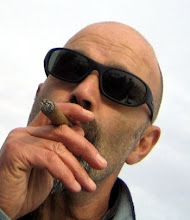I drag myself around town in the sweltering heat like a reluctant snail.
I seek refuge in an icy air-conditioned cafe for a premature lunch.
Reluctant ever to leave I get stuck into Graham Greene's 'A Quiet American', which is set in a Saigon of almost 60 years ago. All the street names are French, and the Americans are only just beginning to become deviously involved. A city of terrorist attacks, bombs, assassinations. Marvellously evocative, like a 'film noir.' Did they ever make a film of it? I must track down the Hotel Continental where the expats and journalists mingled on the terrasses, and killed time in drink. Does it still exist?
I crawl across the road to the War Museum, and stay there for hours, rapt.
The 'Quiet American' of the story was killed early on, before even the French had left, but many hundreds of thousands came here to replace him in subsequent years, and the museum traces the ensuing conflict, mainly in photographs.
Many photographers of all nations died here.
Larry Burrows, a Londoner, worked for Life magazine and pioneered the use of colour photography in his photo-journalism, which was still rare. An unprecedented and highly influential 14-page colour spread was published in Life. He was killed in a helicopter crash in Laos in 1971, with several colleagues.
Dickey Chapelle from Wisconsin, christened Georgette Louise, died in 1965 of wounds.
Sean Flynn (son of Erroll), went missing with his companion Dana Stone on Cambodian Route J. They are pictured, young and dashing on their motorbikes, the day they left towards a Vietcong roadblock.
Kyoishi Sawada, a Japanese, died in Cambodia 1970. His Pulitzer prize winning photo of escaping villagers crossing a river is on show, as is a later picture of him and the same villagers in safety.
Many others are remembered.
Perhaps the most famous was Robert Capa, who had already covered Spain, and many terrains in the Second World War. He was at the Normandy landings in 1944, and followed on to Paris. He was a Jew from Budapest, glamorous and brave it's said, and had a romance with Ingrid Bergmann, which was apparently the subtext and inspiration of Hitchcock's Rear Window! He also found time to set up Magnum Agency in 1947.
David Halberstam wrote in his book 'Requiem ' :
"We who were print people, and who dealt only with words and not images, always knew that the photographers were the brave ones, and they held in that war - which began in an era of still photography and ended with colour film and videotape, beamed by satellite to TV stations all over the world - a special place in our esteem. We deferred to them, reporter to photographer, as we did in few other venues"
While I look at the deeply moving photos the air seems to congeal, I sweat profusely, and the heavens open with a massive and prolonged hammering on the tin roof of the Museum. The tanks and airplanes in the yard disappear behind sheets of rain. Catharsis? How would it have been to fight in conditions like this? Unimaginable. I spend another couple of hours wandering, and wondering at all this madness. More terrible images of the aftermath of War. Too much to bear really, but I need to see it all. To witness and honour.
Subscribe to:
Post Comments (Atom)

No comments:
Post a Comment